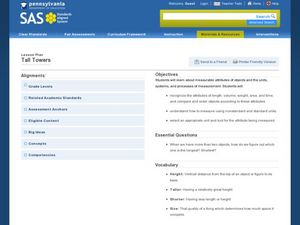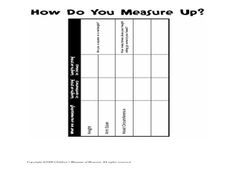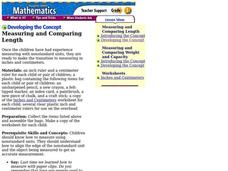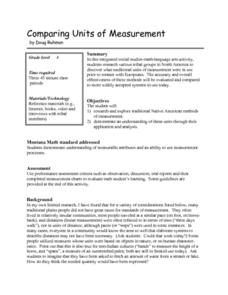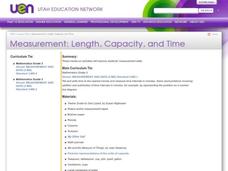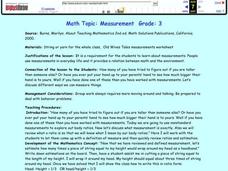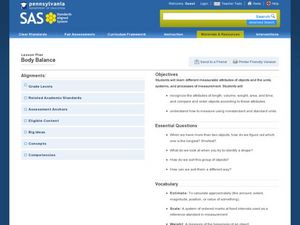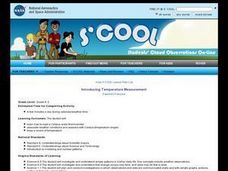Curated OER
It's About Time!
Students examine concept of time, and explore difference between analog and digital clocks; students make art project to represent time and create a time-story problem and solution.
Curated OER
Measure Up!
Discover ways to measure items without standard tools. In this measurements lesson, learners estimate how long certain objects are by measuring with a non-standard measuring tool. Students check their estimates with a ruler and share...
Curated OER
Measurement
Students investigate non-standard linear measurement. In this cross curriculum measurement lesson, students listen to the book Measuring Penny by Loreen Leedy, and identify pages in which non-standard measurement is used. ...
Curated OER
Tall Towers
Linear measurement is the focus of this math lesson. Youngsters work in groups to build towers with blocks. They build towers represented on index cards and determine how many blocks taller one tower is.
Curated OER
Measurement: The Size is Right
Specific learning goals are grouped for different grade levels spanning pre-kindergarten to eighth grade. After preparing the questions and materials, you call a learner to come in front of the class and play the game. Young learners...
National Security Agency
Awesome Area - Geometry and Measurement
Break out those math manipulatives, it's time to teach about area! Capturing the engagement of young mathematicians, this three-lesson series supports children with learning how to measure the area of squares, rectangles, and other...
Curated OER
How Do You Measure Up?
Students measure their body. In this measurement lesson, students use a string to measure their height and the circumference of their head. They record this information on the worksheet provided and answer questions as a group.
Curated OER
Measuring Fun
First graders practice measuring. In this measuring lesson, 1st graders read the story How Big Is a Foot? by Rolf Myller. They measure a partner using standard (ruler) and nonstandard (feet) units.
Curated OER
Measuring and Comparing Length
First graders use rulers to measure in both standard notation and centimeters. In this measuring lesson, 1st graders discuss the importance of a measuring standard. Students measure in inches and centimeters. Students compare inches to...
Curated OER
Comparing Units of Measurement
Fourth graders investigate the units of measurement used by various Native American tribes before they had contact with the Europeans. They write research questions, conduct research using a variety of resources, in small groups write a...
Curated OER
Measurement: Length, Capacity, and Time
Third graders listen to Susan Hightower's, "Twelve Snails to One Lizard" and discuss the need for standard units of measurement. They make a body model on butcher paper which they use to measure their body parts and complete a worksheet....
Curated OER
Make Me Metric
Sixth graders explore standard and nonstandard measurement. For this measurement lesson, 6th graders estimate the lengths of different objects and write about their observations during measuring. Students work in groups to...
Curated OER
Measure Me!
Third graders use nonstandard concrete methods to estimate and record measurements of their body.
Curated OER
Geometry- Hands and Feet
Students identify units of measurement. In this measurement lesson, students predict the length and width of their hands and feet. Students discuss their findings and if their predictions were correct.
Curated OER
Measurements
Third graders brainstorm a list how they use measurements everyday. Using string, they cut a piece long enough as their height and complete ratios using their arms and legs about old tales about measurements. They compare and contrast...
Curated OER
Body Balance
Examine measurable characteristics of objects to build an understanding of the different ways you can discuss an object's size when comparing it to other objects. After whole group instruction, the class compares and organizes several...
Curated OER
The Big Hand Challenge
Students utilize a computer spreadsheet to record and analyze data. In this problem solving lesson, students compare their hand size to that of the principal. Students understand standard and nonstandard measurement.
NTTI
What Size Is It Anyway?
A fabulous plan on teaching basic concepts of measurement to young learners. Pupils use nonstandard units to measure length, practice using a ruler and a yardstick, compare the length of two objects, and perform estimations of length....
Curated OER
Introducing Temperature Measurement
Young scholars explore temperature and use Celcius thermometers to measure and graph the temperature in the classroom daily. They estimate what they think the temperature might be and then find the actual temperature in the room.
Curated OER
Measuring: Why Can't We All Just Get Along?
Young scholars examine why having standardized units of measurement is important. They investigate the use of non-standard measure, twigs, while measuring the piece of tape. Next, they experiment with straws, paper clips, and rulers...
Curated OER
Johnny Appleseed Walkabout
Second graders calculate mileage for a journey. In this place value and measurement lesson, 2nd graders read Johnny Appleseed, work in groups to locate his birthplace on a map, locate the other states he stopped in, and measure the...
Curated OER
Comparing and Ordering Numbers
Pupils compare, order, and measure objects. In this measurement lesson plan, students are assessed on their ability to order, compare, and measure objects. This is an assessment only lesson plan and does not include instruction.
Curated OER
Inchworm
Students discover the basic concept of measuring. For this mathematics relationship lesson, students identify length, volume, weight, time and area in order to measure different units. Students measure items using different...
Curated OER
A Look At Rocks
Students write letters to organizations, such as United States Geological Society, to find out more about rocks. Students write about a pretend time they found a magic pebble. Students calculate distances to travel to see various...





